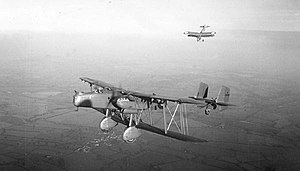Handley Page Heyford
| HP.50 Heyford | |
|---|---|
 |
|
| Role | Heavy night bomber |
| Manufacturer | Handley Page Aircraft |
| Designer | George Rudolph Volkert |
| First flight | 12 June 1930 |
| Introduction | 1934 |
| Retired | 1941 |
| Primary user | Royal Air Force |
| Produced | 1933 - 1936 |
| Number built | 125 |
The Handley Page Heyford was a twin-engine British biplane bomber of the 1930s. Although it had a short service life, it equipped several squadrons of the RAF as one of the most important British bombers of the mid-1930s, and was the last biplane heavy bomber to serve with the RAF. The aircraft was named for and first deployed at RAF Upper Heyford, near Bicester in Oxfordshire.
The Heyford was built to meet Air Ministry specification B.19/27 for a heavy night bomber to replace the Vickers Virginia, which required a twin-engined aircraft capable of carrying 1,546 lb (700 kg) of bombs and flying 920 miles at 115 mph (185 km/h). The specification resulted in a large number of proposals being submitted by the British aircraft industry, with designs by Fairey (the Fairey Hendon) and Vickers (the Type 150 and Type 163 being built) as well as Handley Page's design. The prototype, the Handley Page HP.38, was designed by Handley Page's lead designer G. R. Volkert and first flew on 12 June 1930 at Handley Page's factory at Radlett, powered by two 525 hp (390 kW) Rolls-Royce Kestrel II engines driving two-blade propellers.
The aircraft was of mixed construction having fabric-covered, two-bay metal-frame wings, while the fuselage had an aluminium monocoque forward section with a fabric-covered frame to the rear, It had a crew of four, consisting of a pilot, a bomb aimer/navigator/gunner, a radio operator and a dorsal/ventral gunner. Open positions were provided for the pilot and both the nose and dorsal gunners. The Heyford had a novel configuration, with the fuselage attached to the upper wing — somewhat like the 1914-designed German Gotha G.I — and with the bomb bay in the thickened centre lower wing. This provided a good defensive field of fire for the nose and dorsal guns as well as the ventral retractable "dustbin" turret, each equipped with a single .303 in (7.7 mm) Lewis Gun. The fixed undercarriage consisted of large, spat-covered wheels. The design allowed ground crews to safely attach bombs while the engines were running, but the result was that the pilot was some 17 ft (5 m) off the ground.
...
Wikipedia
